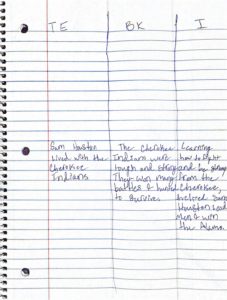 Why I Picked It Up:
Why I Picked It Up:
One super popular session that Sherry and I present is Historical Fusions: Integrating ELA/R, Social Studies, and Technology. I picked up this book to help first and fourth grade teachers teach their students about Sam Houston.
Why I Finished It:
Truthfully, I learned a lot about Sam Houston’s early life that was new to me. I had taught the Alamo and about his part in history, but was intrigued with his earlier life and what role that would play on who he became.
Who I Would Give It To:
Teachers who are required to teach about Sam Houston and to any child interested in wars and battles. This book could easily stretch K-12. In addition, this is part of a series! There are lots of A Picture Book of [insert the name of your historical figure here]!
Integration Ideas
Establishing a Purpose & Social Studies
It is so important that students learn how to establish their own purposes for reading, but sometimes it’s the teacher’s job to establish the purpose for reading. I feel strongly that this is the case whenever the teacher is using the book to teach content area curriculum. In first grade (according to Texas state standards), students should learn how Houston helped shape the community, state, and nation. They need to understand what his contributions were. In fourth grade (again, Texas state standards), students must learn how Sam Houston was important to the founding of Texas as a republic. So the standard becomes the purpose for reading. While it will be interesting to find out more about Sam Houston, like where he was born, if he married, and all those other fun facts, what students REALLY need to know about are his contributions to the formation of Texas.
Retelling & Summarizing
The first two pages of this book recount the historical event of the battle of the Alamo, history textbook style. I wouldn’t call it “boring”, but it is definitely more on the nonfiction side of literature than a literary nonfiction biography would be. On day one, I only read those first two pages. There are beautiful illustrations by Matt Collins on these pages. Once the two pages are read aloud, I have students pull out the main events and write them on sentence strips. Students put the events in order and we all practice retelling the important events. Truth is, this covers the social studies content. If your students are summarizing instead of retelling, have them each write a summary of the importance of Sam Houston to Texas. Remember that, to summarize, students must find the main ideas first, determine the important details, and then sequence the ideas.
After the first two pages, the literary nonfiction biography begins with Houston being born in Virginia 1793. I read aloud the next two pages, and on the second of those pages, it talks about how Houston lived with Cherokee Indians for three years. They taught him to speak, dress, and hunt like a Cherokee. I stop on this page and have students make inferences about how this experience will shape Houston to accomplish what he did at the Alamo. The students, because they already have the factual information about the Alamo from day one, are able to answer this inference question. I have students draw three columns in their journals to answer this question. The first column is for text evidence, the second column is for background knowledge (schema), and the third column is for their inference.
Houston being born in Virginia 1793. I read aloud the next two pages, and on the second of those pages, it talks about how Houston lived with Cherokee Indians for three years. They taught him to speak, dress, and hunt like a Cherokee. I stop on this page and have students make inferences about how this experience will shape Houston to accomplish what he did at the Alamo. The students, because they already have the factual information about the Alamo from day one, are able to answer this inference question. I have students draw three columns in their journals to answer this question. The first column is for text evidence, the second column is for background knowledge (schema), and the third column is for their inference.
Once they complete this inference, I read a couple more pages and present another inference question. I continue throughout the story.






Leave a Reply